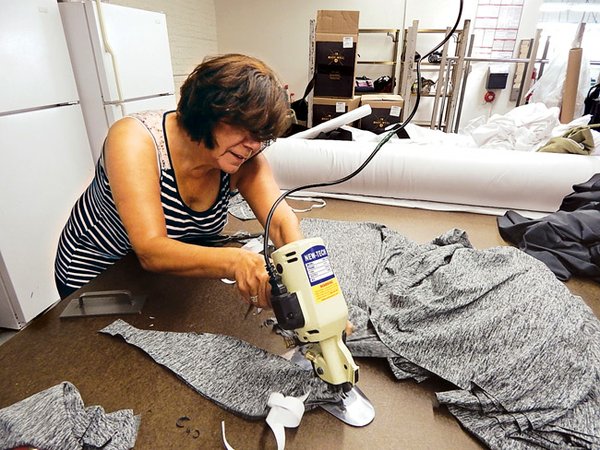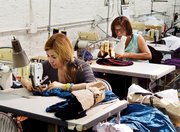THE BIG CUT: Maro Takourian is a long-time sample maker at Gem Sewing in Los Angeles, where a new service called Made-Well-LA is located. Made-Well-LA offers full-package services and advice for designers wanting to produce their goods in Los Angeles.
MADE IN LA
More Services Jump In to Bring Apparel Production Back to Los Angeles
When Mike Basteguian was growing up in Los Angeles, his family’s garment factory was one of 80 clothing contractors in the early 1990s that blanketed various spots in Hollywood.
Today, there are only a handful of factories, two of which are owned by the Basteguians. “It was completely the opposite then of what it is now,” said Marie Basteguian, Michael’s mother, who started those two factories more than two decades ago when she made men’s shirts for Cavaricci and women’s tops for Fred Segal.
Now Mike Basteguian is trying to bring back some of that garment glory with a new venture he has forged to help designers and clothing companies make their creations in Los Angeles. Called Made-Well-LA, his company is a full-package resource that takes a concept and helps carry it forward to the final product. He likes to refer to himself as an “apparel concierge,” whose company has a website at www.madewellla.com.
“With all the production experience we have between us here, we can help brands. Any mistake they make can set them back thousands of dollars. That can bury a small- to mid-size company. One production mistake or the loss of a customer, they are out of business,” said Mike Basteguian, noting that he wants to keep his minimums at a low 150 to 300 and can turn products in three to four weeks.
Basteguian is just one of many clothing-industry insiders trying to capitalize on the wave of companies that want to shift all or some of their overseas production to Los Angeles or help start-ups become familiar with the ins and outs of a seam and a button hole.
Houman Salem, a lingerie and apparel maker as well as an e-commerce retailer, is taking it a step further. He just began compiling an online directory of Southern California garment manufacturers, textile producers, accessories makers, pattern makers, label providers, logistics services and legal services as well as marketing and public relations that work with apparel and textile companies.
His endeavor is called Made by Los Angeles (www.madebylosangeles.com), which also comes with a Made by Los Angeles hangtag program he designed and developed. “All the listings go through a professional review,” said the entrepreneur.
It costs $59 a month to be listed in the online directory, which has a dedicated page that is like a micro-site that contains photos, videos, descriptions and business information. Apparel factories such as Indie Source and 9B Apparel are on the site as is LA Dye & Print.
Users can access the directory for free, unlike Makers Row,another online apparel directory that covers the United States. Salem said the listing service is intended for independent designers, small- to mid-sized businesses and corporations that seek reputable Los Angeles–based service providers to the fashion and apparel industry. “We need to create awareness,” Salem said. “My vision is that in two years we have enough people to create a local sourcing show.”
The venture’s hangtag program is available to all licensed LA–based garment makers. The hangtags’ logo is a sewing machine in the center surrounded by the words “Made by Los Angeles.”
Salem has 10,000 of the tags stored in his warehouse. For directory members, the hangtags cost 10 to 12 cents each. They will be around 15 to 18 cents each for non-directory members.
Salem’s hangtag program is similar to the one developed in 2012 under the auspices of then-Mayor Antonio Villaraigosa. The mayor’s office put out the call for someone to create a garment hangtag/logo that could be used by clothing companies that manufacture or design in Los Angeles.
That logo showed a hand holding a sewing needle surrounded by the words “Designed & Made in Los Angeles” with the ampersand formed by a piece of thread. It was unveiled at a press conference at the Cooper Design Space.
But the hangtag concept pretty much died when Villaraigosa left office in 2013. Salem contacted the Office of Economic Development for the new mayor, Eric Garcetti, to inquire about the fate of the apparel hangtag. He learned the logo had never been trademarked and was not being used.
So he decided to create his own hangtag after talking with Glyn Milburn, who works in the mayor’s economic development office. “We strongly support efforts like Made by Los Angeles that aim to build upon our strong creative and manufacturing bases to create jobs,” said Milburn, who played in the NFL for 10 years before turning to business development and entrepreneurship.
Small is beautiful
Made-Well-LA and Made by Los Angeles are two newer ventures that were recently at the Sourcing at MAGIC show in Las Vegas to generate new business. But other entities have been at it for longer with mixed success.
A recently launched website, called the American Brand Project, is trying to connect shoppers with Made in USA products that include apparel, cosmetics, pet supplies, food, beverages, and home and garden goods.
The website lets brands set up their own online stores. To be on the website is free, with the American Brand Project taking a 5 percent commission on sales.
Already, Los Angeles–based Rising Sun blue jeans is signed up as well as Bikini Thief, based in Pasadena, Calif.
American Brand Project, based in Encinitas, Calif., had a launch party in West Hollywood, Calif., on Aug. 20, hoping to reach out to more Los Angeles apparel companies. “This particular party was targeted to the fashion and apparel industry, where brands are heavily represented in Los Angeles and California,” said Andrew Henderson, co-founder of the site. “We are much more interested in putting consumers in contact with companies that produce in the United States.”
So far, there are around 300 brands represented on the site, located at www.americanbrandproject.com.
Randa Allen at The Trendchasers, a full-package facility in downtown Los Angeles, said her company has had to adjust what it charges for its various services in order to make a profit.
Now it bills the client for development and has set its minimums to 500 pieces. “People don’t realize what it takes to develop a garment,” she said. “Sometimes the development is more costly than making the garment.”
The Trendchasers keeps track of how much time is spent on pattern making and how many lab dips are done in dyeing a garment. “A lot of times the customer changes their mind,” Allen said, noting that many changes lead to a more expensive process.
Many of the clothing they find being manufactured here are made of synthetic fabric, such as yoga wear and activewear. That’s because imported garments made of synthetic fabric can have a duty that is nearly 33 percent of the cost of the garment.
“I feel like the people who are manufacturing overseas want to do some made in America. We find that people want to bring some things back, but it is not the whole thing,” Allen said. “Also, I think the community wants made in America, but they don’t’ want to pay American prices.”

























